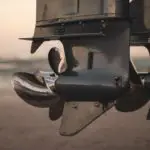How would you go about building a piston for a boat? This question was asked by a friend who wanted to build his own boat.
He had no idea where to start or what materials he needed to get started.

The piston is a type of engine component that helps convert energy from combustion into motion.
The piston is also known as a cylinder liner or a cylinder head gasket. A piston consists of two parts: the cylinder and the rod.
The cylinder has a hole at its top and bottom. The rod fits inside the cylinder and connects to the piston pin.
The piston pin moves back and forth within the hole. When the piston pin moves, it pushes the water out of the cylinder.
As the piston pin moves in one direction, it pulls water into the other side of the cylinder.
In this article, we will cover how to make a simple piston for your boat. We have also included a list of the tools and materials you will need.
What Is A Piston?
A piston is a part of an internal combustion engine that moves back and forth inside a cylinder. There are two kinds of pistons: single and double.
Single pistons are found in engines with only one cylinder. While double pistons are most common in four-cylinder engines.
In most cases, the piston takes the form of a cylindrical metal rod that fits snugly into the engine.
It pushes on the walls of the cylinder when it’s moving up and down. When you turn your boat over, the piston moves up and down inside its cylinder.
The piston has many functions. For example, it pushes on the valves to open them. When the valve opens, air enters the chamber above the piston.
This allows fuel to enter the chamber, which then ignites and forces the piston downward. This movement compresses the mixture of gas and air.
As the mixture expands, the pressure increases until it reaches a point where the piston can’t hold any more pressure.
At this point, the force pushing upward on the piston causes the piston to rise again. This process repeats itself several times before the piston finally stops.
Why Make Your Own Piston?
One advantage to making your own piston is that you control all aspects of the design.
You can choose exactly which type of material you want to use for the body of the piston.
You can also decide if you want to add any features such as a handle or a safety switch.
Another advantage to making your own is that you can save money. If you buy a pre-made piston, you may pay more than $100.00 for a basic model.
However, if you make your own, you can cut the cost in half. You can also customize your piston to fit your needs.
There are several ways to attach the piston to the boat. If you want to use your piston as a starter motor, you can simply connect it to the battery.
And, if you want to attach it to the prop shaft, you can drill holes in the piston and bolt them together.
If you want to use your homemade piston as a vacuum cleaner, you can just remove the rod and replace it with a hose.
What You Will Need
To make your own piston, you will need some basic tools such as a drill, screwdriver, hammer, pliers, ruler, pencil, tape measure, wood glue, sandpaper, and nails.
You may also want to have an electric sander handy.
In the section below, we have provided a checklist of the tools and materials you will need before you can make your piston.
Tools & Materials Checklist
- Drill with bits ranging from 1/8” to 3/16”
- Sanding block (optional)
- Screwdriver
- Hammer
- Pliers
- Ruler
- Tape Measure
- Wood Glue
- Nails
Once you have gathered the tools and materials you need, you can start making your own piston using the instructions below.
How To Make A Piston
Step 1: Measure Your Parts
Before you can begin making your piston, you first need to know the length and diameter of the cylinder.
The length of the cylinder should be equal to half the distance between the center of the holes on the sides of the cylinder.
The diameter of the cylinder should be twice the diameter of the rod that you plan to use.
You can find the diameter of the rod by measuring the distance across the end of the rod.
If you do not have a tape measure, you can use the width of the rod as a guide.
Step 2: Cut Out Cylinder Shape
Using your tape measure, mark off the exact dimensions of the cylinder shape onto a piece of paper. Then cut out the shape using a jigsaw.
Be careful when cutting because if you accidentally cut too deep, you could damage your work surface.
Step 3: Draw Out Holes
Once you have cut out the shape of the cylinder, draw out the holes for the piston pin.
These holes must be large enough so that the piston pin can fit easily into them.
Step 4: Sand Down Cylinder Surface
Sand down the outside of the cylinder until it is smooth. Use a sanding block if necessary.
Do not sand any deeper than 1/4” or else you risk damaging the walls of the cylinder.
Step 5: Mark Off Hole Locations
Mark the locations of the holes on both ends of the cylinder. Using a marker, draw lines around each hole location.
Step 6: Drill Holes
Drill holes through the marked locations. Try to keep the depth of the holes consistent throughout the entire cylinder.
Step 7: Attach Rod
Attach the rod to the piston pin using wood glue. This step is optional but recommended.
It helps prevent the piston from moving while you are working on it.
Step 8: Sand Outer Surfaces
Use the sanding block again to sand the outer surfaces of the cylinder. Keep in mind that the cylinder should be smooth and free of sharp edges.
Step 9: Finish Touches
Use the electric sander to finish up the inside of the cylinder. Start at one end and slowly move towards the other.
Step 10: Assemble Piston
Now that you have everything ready, assemble the piston. First, attach the rod to the piston pins using wood glue.
Next, insert the piston pin into the two holes located at either end of the cylinder. Finally, slide the piston over the rod.
You may want to add some screws to help secure the piston to the rod.
In Summary
And there you have it! Now you can make your very own boat piston.
We hope this tutorial was useful and that you will continue to refer to it in the future.
- How To Make A Piston - May 12, 2022
- What Is A Vapor Lock? - May 12, 2022
- 19 Boater Gift Ideas – Must Haves For A New Boat Owner - February 2, 2022


